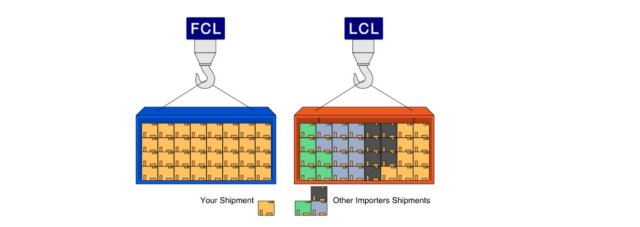
At Moving Solutions, we understand that freight forwarding shipping can be a daunting task, especially if you don’t have the right partners. Our team is here to make your shipping experience as smooth and stress-free as possible. When it comes to shipping your goods, it is crucial to choose the right mode of transportation. If you opt for sea or ocean freight, you will be faced with the decision between FCL (Full Container Load) and LCL (Less than Container Load) shipping.
The choice between FCL vs. LCL shipping is important for businesses that plan to transport their goods through waterways. The type of container you choose will depend on several factors, such as the size, nature, and volume of your shipment.
We know that making the right decision is key when it comes to container shipping. That’s why we have compiled a comprehensive comparison of FCL vs. LCL shipping to help you determine the best option for your shipment.
FCL vs. LCL Shipping
The key difference between LCL and FCL shipping is the amount of space rented. FCL stands for Full Container Load, where a single consignee rents the entire container. In international shipping, the shipper rents the entire container for their cargo and does not have to share it with others, providing more security and simplifying ocean freight shipping.
LCL, or Less than Container Load, is used when the shipper’s cargo is too small to fill a full container. It is a cost-effective option for shipping smaller shipments.
Freight forwarding involves choosing between FCL and LCL shipping options. Freight forwarders often use LCL containers for consolidation by combining multiple cargoes. Meanwhile, FCL containers are booked as a whole and consolidated with cargo from various shippers.
Key Differences Between FCL vs. LCL
- The cost of LCL exceeds that of FCL as the volume of the cargo increases.
- FCL shipping is for heavy and bulky goods, while LCL is for small and portable ones.
- Generally, FCL rates are volatile, while LCL rates are more stable.
- For heavy cargo, half-height containers are the most suitable option.
- Bulkers are ideal for granular shipments.
- Cars and other vehicles are transported with collapsible racks.
What are FCL and LCL in shipping terms?
Waterway freight forwarding requires booking either an FCL or LCL container. FCL shipments require booking a whole container, while LCL shipments only require a portion.
With FCL, the goods are owned by a single company, while in LCL there may be goods from multiple companies.
For quicker delivery, exporters should choose FCL as it has a faster delivery time compared to LCL. This is because FCL containers are booked by a single company, avoiding the need for unpacking and sorting at different locations or ports. On the other hand, LCL shipping takes longer due to additional time for sorting, processing, and consolidating documents, as well as increased time for loading and unloading.
Shipment Cost: LCL vs. FCL
Minimizing cost is crucial in freight forwarding shipping. While booking an FCL or LCL container may be more expensive in terms of total shipment cost, FCL is more cost-effective if the shipment is large and dimension-wise cost is taken into consideration. However, for smaller cargo, LCL is the logical option.
When deciding between FCL and LCL, shippers need to consider the costs of both options, as well as destination service charges and haulage charges, which the buyer may recover but may impact future business due to price escalation.
To determine the cost-effectiveness of LCL, exporters can calculate its cubic meter. Both FCL and LCL charge freight on a full container load basis, however, in LCL, the freight charge is based on the volume of cargo.
Which one is Better: FCL vs. LCL
In comparing FCL and LCL shipping options, there are several factors to consider.
One key factor is transit time. With LCL shipping, the shipment moves only once the forwarder has enough cargo to fill a container, which can result in multiple transhipment delivery ports and longer transit time. When considering LCL, the exporter should factor in the stuffing date, transhipment schedule, carrier itinerary, and expected delivery date.
The decision between FCL and LCL shipping is straightforward when the cargo volume is very large or small. However, when making the choice, the shipper must weigh the shipment cost against the speed and convenience of the logistical process. Containers are a convenient and durable option for transporting cargo overseas, made of materials such as aluminium, steel, and fibre polymer. They come in standard sizes, ranging from 8 to 40 feet, in accordance with ISO (International Organization for Standardization) specifications.
